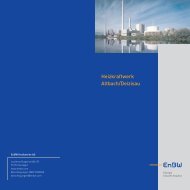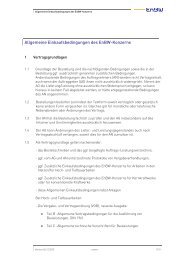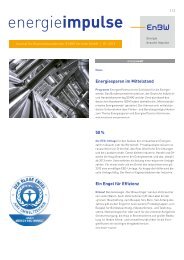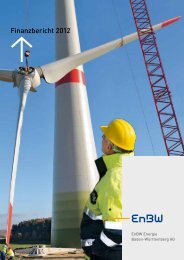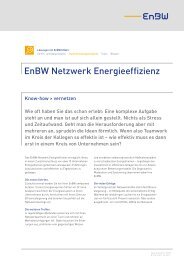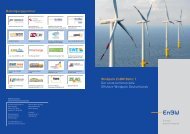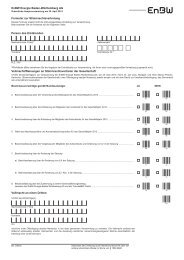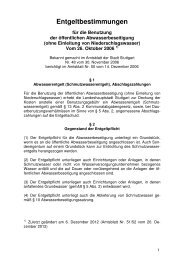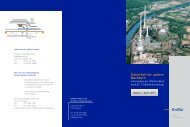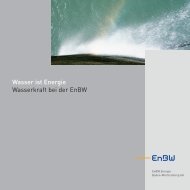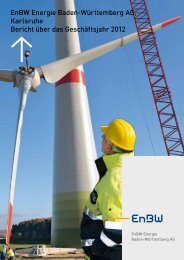Environmental Report 2000 - EnBW
Environmental Report 2000 - EnBW
Environmental Report 2000 - EnBW
Create successful ePaper yourself
Turn your PDF publications into a flip-book with our unique Google optimized e-Paper software.
State of the Environment <strong>Report</strong><br />
Water Output – Cooling Water<br />
in million m 3<br />
3,500<br />
3,000<br />
2,500<br />
2,000<br />
1,500<br />
1,000<br />
500<br />
0<br />
By oxygenating the recovered cooling<br />
water with water cascades, air jets or<br />
cooling towers as well as by cleaning<br />
it of large quantities of rubbish, our<br />
power plants are making a vital contribution<br />
to improved river water quality.<br />
Last year our power plant sites removed<br />
3,401 tonnes of dirt (rakings)<br />
from river water. Where feasible we<br />
turned this rubbish to compost. Noncompostable<br />
material such as plastic<br />
bottles and tin cans is graded and<br />
recycled.<br />
32<br />
3,038.11<br />
1997<br />
Cooling Water<br />
2,141.97<br />
1998<br />
2,264.10<br />
1999<br />
1,740.42<br />
<strong>2000</strong><br />
Water Output – Evaporation Water<br />
in million m 3<br />
70<br />
60<br />
50<br />
40<br />
30<br />
20<br />
10<br />
0<br />
23.71<br />
1997<br />
48.55<br />
1998<br />
Evaporation Water<br />
44.57<br />
1999<br />
Electro-magnetic fields<br />
50.83<br />
<strong>2000</strong><br />
Power for our customers is conveyed<br />
over our grid to the end user. When<br />
electricity flows through a cable it<br />
produces an electro-magnetic field<br />
which, although not generally detectable<br />
by normal human senses, is easily<br />
measured on a technical instrument.<br />
The debate on whether electro-magnetic<br />
fields cause an adverse effect<br />
on human health has been given a<br />
solid grounding with the definition of<br />
precautionary critical values following<br />
the 1997 enactment of the 26th<br />
ordinance based on the “BImSchG”<br />
law on immission control.<br />
Water Output – Waste Water<br />
in million m 3<br />
1.2<br />
0.9<br />
0.6<br />
0.3<br />
0<br />
0.14<br />
0.08<br />
3500<br />
3000<br />
2500<br />
<strong>2000</strong><br />
1500<br />
1000<br />
0.24<br />
0.83 1.13 500 0.57 0.43<br />
0<br />
1997 1998 1999<br />
Waste Water (sewage system)<br />
Waste Water (direct discharge)<br />
0.24<br />
<strong>2000</strong><br />
Over the past few years we have<br />
monitored our facilities to ascertain<br />
their compliance with the provisions<br />
and critical values laid down in the<br />
ordinance. Two transformers have<br />
been modified to ensure full compliance.<br />
Wherever possible we opt for standardised<br />
facilities registered with the<br />
appropriate inspection authorities or<br />
with manufacturer’s certification.<br />
Transformers without that hum<br />
Machines 60 can make a lot of noise. 1,5Noise<br />
pollution is a major environmental problem in<br />
50<br />
Germany. One of the chief sources 1,2of<br />
noise is road traffic. Fortunately there is a whole<br />
40<br />
battery of technological options for 0,9 reducing noise pollution levels.<br />
30<br />
20<br />
Power 10 plants and other facilities are<br />
often 0 situated near residential areas.<br />
This makes effective acoustical insulation<br />
a matter of special concern.<br />
Low-noise motors and ventilators,<br />
sound-dampening insulation and<br />
sound-deadening walls all help to reduce<br />
the sound level to within official<br />
critical limits.<br />
Our commitment to nature conservation<br />
can be illustrated in a number of<br />
ways from greening of roofs and planting<br />
open land with local flora and our<br />
comprehensive ecologically friendly<br />
cable routing policy to the creation of<br />
nesting sites for endangered bird species<br />
such as the migratory falcon and<br />
the systematic ecological approach<br />
we adopt with our river power plants.<br />
In cooperation with the Ministry for<br />
the Environment, we have launched<br />
an extensive programme for the pro-<br />
0,6<br />
0,3<br />
Integrated sound dampeners in<br />
power 0,0 plant chimneys<br />
In our plants we draw up “noise matrix<br />
diagrams”. Employees in areas with<br />
particularly high noise levels are provided<br />
with noise-protection equipment.<br />
Our noise reduction programme has<br />
been designed for a quieter working<br />
environment with a range of measures<br />
including removing the characteristic<br />
“hum” from our new transformers<br />
tection of large birds which involves<br />
equipping medium-voltage pylons<br />
with bird deterrents. Last year alone<br />
we equipped around 6,000 pylons<br />
with such devices at a cost of around<br />
€ 1.9 million. The bird protection programme<br />
should be completed by late<br />
2002.<br />
A home for storks in Ettenheim<br />
In the Rheinhausen regional centre<br />
we have equipped a 16-metre high<br />
mast with a stork nest to promote<br />
and integrating sound-dampeners in<br />
the chimneys of our power plants.<br />
The conversion of the 220-kV line<br />
near Ravensburg has lead to a significant<br />
reduction in noise levels. The<br />
monitoring programme to ascertain<br />
noise levels under a number of different<br />
climatic conditions which is being<br />
carried out with the authorities and<br />
private-initiative groups is scheduled<br />
for completion in 2001.<br />
Nature conservation is one of our primary concerns<br />
Technical installations like buildings, power plants or high-tension cables all have an<br />
impact on our environment and on the balance of nature. We are committed to the search<br />
for intelligent and innovative solutions that can minimise or compensate for this impact.<br />
colonisation. The “Nabu” nature conservation<br />
group in Ettenheim will be<br />
responsible for its up-keep and the<br />
local communities hope it will prove<br />
attractive for the birds. A family of<br />
storks found nesting on a pylon in<br />
Stockach near Lake Constance has<br />
been removed and given a new home.<br />
And the Mainhard local branch of the<br />
“Schwäbische Albverein” nature association<br />
has converted a disused<br />
transformer into a one-of-a-kind home<br />
for owls, bats, hedgehogs and bees.<br />
33



